- Typography
- Global settings
- Headings
- Customizing headings
- Display headings
- Lead
- Inline text elements
- Text utilities
- Abbreviations
- Blockquotes
- Naming a source
- Alignment
- Lists
- Unstyled
- Inline
- Description list alignment
- Responsive font sizes
Typography
Documentation and examples for Bootstrap typography, including global settings, headings, body text, lists, and more.
Global settings
Bootstrap sets basic global display, typography, and link styles. When more control is needed, check out the textual utility classes.
- Use a native font stack that selects the best
font-familyfor each OS and device. - For a more inclusive and accessible type scale, we assume the browser default root
font-size(typically 16px) so visitors can customize their browser defaults as needed. - Use the
$font-family-base,$font-size-base, and$line-height-baseattributes as our typographic base applied to the<body>. - Set the global link color via
$link-colorand apply link underlines only on:hover. - Use
$body-bgto set abackground-coloron the<body>(#fffby default).These styles can be found within_reboot.scss, and the global variables are defined in_variables.scss. Make sure to set$font-size-baseinrem.
Headings
All HTML headings, <h1> through <h6>, are available.
| Heading | Example |
|---|---|
<h1></h1> | h1. Bootstrap heading |
<h2></h2> | h2. Bootstrap heading |
<h3></h3> | h3. Bootstrap heading |
<h4></h4> | h4. Bootstrap heading |
<h5></h5> | h5. Bootstrap heading |
<h6></h6> | h6. Bootstrap heading |
<h1>h1. Bootstrap heading</h1><h2>h2. Bootstrap heading</h2><h3>h3. Bootstrap heading</h3><h4>h4. Bootstrap heading</h4><h5>h5. Bootstrap heading</h5><h6>h6. Bootstrap heading</h6>
.h1 through .h6 classes are also available, for when you want to match the font styling of a heading but cannot use the associated HTML element.
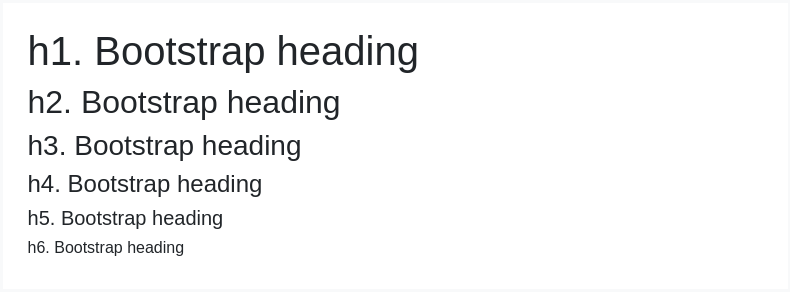
<p class="h1">h1. Bootstrap heading</p><p class="h2">h2. Bootstrap heading</p><p class="h3">h3. Bootstrap heading</p><p class="h4">h4. Bootstrap heading</p><p class="h5">h5. Bootstrap heading</p><p class="h6">h6. Bootstrap heading</p>
Customizing headings
Use the included utility classes to recreate the small secondary heading text from Bootstrap 3.

<h3>Fancy display heading<small class="text-muted">With faded secondary text</small></h3>
Display headings
Traditional heading elements are designed to work best in the meat of your page content. When you need a heading to stand out, consider using a display heading—a larger, slightly more opinionated heading style. Keep in mind these headings are not responsive by default, but it’s possible to enable responsive font sizes.
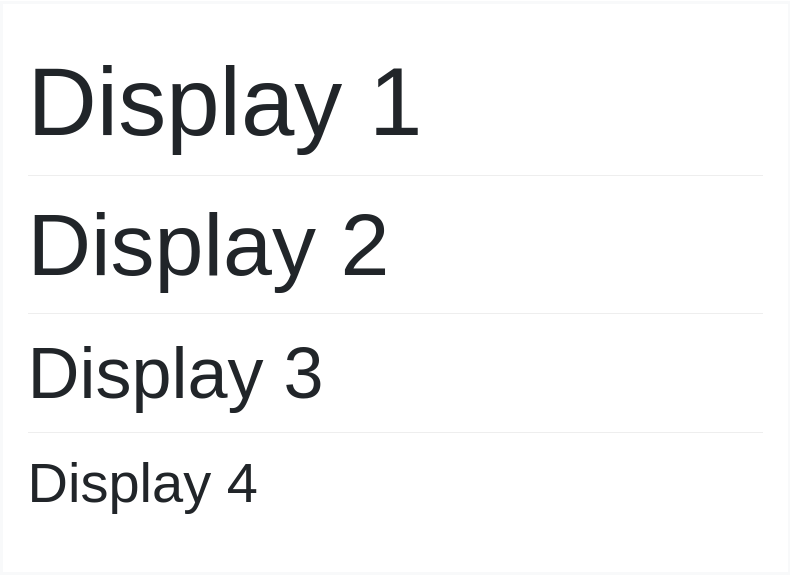
<h1 class="display-1">Display 1</h1><h1 class="display-2">Display 2</h1><h1 class="display-3">Display 3</h1><h1 class="display-4">Display 4</h1>
Lead
Make a paragraph stand out by adding .lead.

<p class="lead">Vivamus sagittis lacus vel augue laoreet rutrum faucibus dolor auctor. Duis mollis, est non commodo luctus.</p>
Inline text elements
Styling for common inline HTML5 elements.
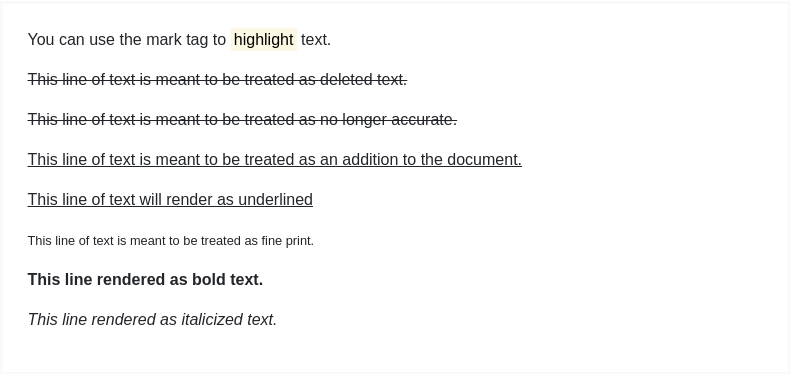
<p>You can use the mark tag to <mark>highlight</mark> text.</p><p><del>This line of text is meant to be treated as deleted text.</del></p><p><s>This line of text is meant to be treated as no longer accurate.</s></p><p><ins>This line of text is meant to be treated as an addition to the document.</ins></p><p><u>This line of text will render as underlined</u></p><p><small>This line of text is meant to be treated as fine print.</small></p><p><strong>This line rendered as bold text.</strong></p><p><em>This line rendered as italicized text.</em></p>
.mark and .small classes are also available to apply the same styles as <mark> and <small> while avoiding any unwanted semantic implications that the tags would bring.
While not shown above, feel free to use <b> and <i> in HTML5. <b> is meant to highlight words or phrases without conveying additional importance while <i> is mostly for voice, technical terms, etc.
Text utilities
Change text alignment, transform, style, weight, and color with our text utilities and color utilities.
Abbreviations
Stylized implementation of HTML’s <abbr> element for abbreviations and acronyms to show the expanded version on hover. Abbreviations have a default underline and gain a help cursor to provide additional context on hover and to users of assistive technologies.
Add .initialism to an abbreviation for a slightly smaller font-size.

<p><abbr title="attribute">attr</abbr></p><p><abbr title="HyperText Markup Language" class="initialism">HTML</abbr></p>
Blockquotes
For quoting blocks of content from another source within your document. Wrap <blockquote class="blockquote"> around any HTML as the quote.

<blockquote class="blockquote"><p class="mb-0">Lorem ipsum dolor sit amet, consectetur adipiscing elit. Integer posuere erat a ante.</p></blockquote>
Naming a source
Add a <footer class="blockquote-footer"> for identifying the source. Wrap the name of the source work in <cite>.

<blockquote class="blockquote"><p class="mb-0">Lorem ipsum dolor sit amet, consectetur adipiscing elit. Integer posuere erat a ante.</p><footer class="blockquote-footer">Someone famous in <cite title="Source Title">Source Title</cite></footer></blockquote>
Alignment
Use text utilities as needed to change the alignment of your blockquote.

<blockquote class="blockquote text-center"><p class="mb-0">Lorem ipsum dolor sit amet, consectetur adipiscing elit. Integer posuere erat a ante.</p><footer class="blockquote-footer">Someone famous in <cite title="Source Title">Source Title</cite></footer></blockquote>

<blockquote class="blockquote text-right"><p class="mb-0">Lorem ipsum dolor sit amet, consectetur adipiscing elit. Integer posuere erat a ante.</p><footer class="blockquote-footer">Someone famous in <cite title="Source Title">Source Title</cite></footer></blockquote>
Lists
Unstyled
Remove the default list-style and left margin on list items (immediate children only). This only applies to immediate children list items, meaning you will need to add the class for any nested lists as well.
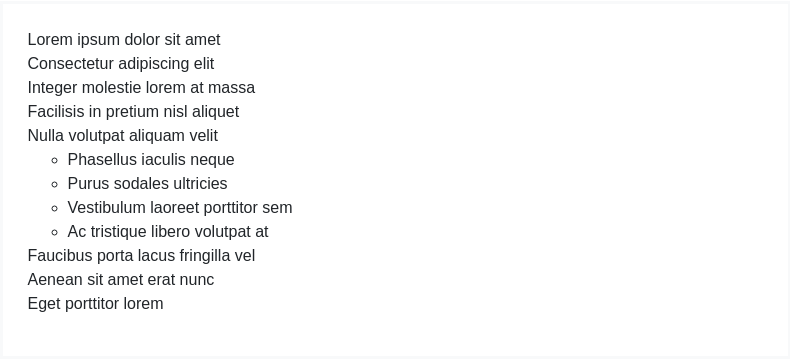
<ul class="list-unstyled"><li>Lorem ipsum dolor sit amet</li><li>Consectetur adipiscing elit</li><li>Integer molestie lorem at massa</li><li>Facilisis in pretium nisl aliquet</li><li>Nulla volutpat aliquam velit<ul><li>Phasellus iaculis neque</li><li>Purus sodales ultricies</li><li>Vestibulum laoreet porttitor sem</li><li>Ac tristique libero volutpat at</li></ul></li><li>Faucibus porta lacus fringilla vel</li><li>Aenean sit amet erat nunc</li><li>Eget porttitor lorem</li></ul>
Inline
Remove a list’s bullets and apply some light margin with a combination of two classes, .list-inline and .list-inline-item.

<ul class="list-inline"><li class="list-inline-item">Lorem ipsum</li><li class="list-inline-item">Phasellus iaculis</li><li class="list-inline-item">Nulla volutpat</li></ul>
Description list alignment
Align terms and descriptions horizontally by using our grid system’s predefined classes (or semantic mixins). For longer terms, you can optionally add a .text-truncate class to truncate the text with an ellipsis.
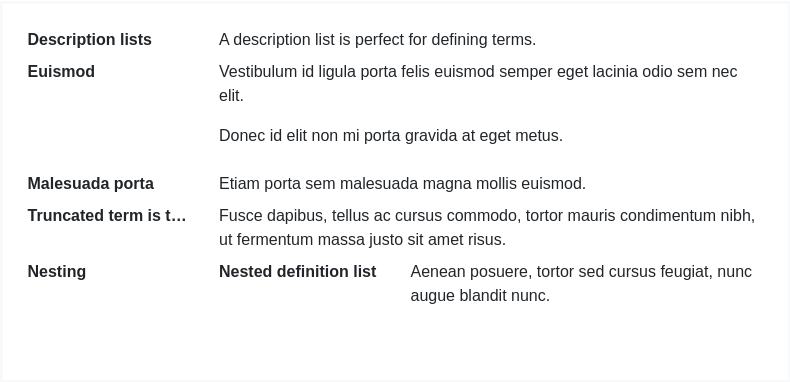
<dl class="row"><dt class="col-sm-3">Description lists</dt><dd class="col-sm-9">A description list is perfect for defining terms.</dd><dt class="col-sm-3">Euismod</dt><dd class="col-sm-9"><p>Vestibulum id ligula porta felis euismod semper eget lacinia odio sem nec elit.</p><p>Donec id elit non mi porta gravida at eget metus.</p></dd><dt class="col-sm-3">Malesuada porta</dt><dd class="col-sm-9">Etiam porta sem malesuada magna mollis euismod.</dd><dt class="col-sm-3 text-truncate">Truncated term is truncated</dt><dd class="col-sm-9">Fusce dapibus, tellus ac cursus commodo, tortor mauris condimentum nibh, ut fermentum massa justo sit amet risus.</dd><dt class="col-sm-3">Nesting</dt><dd class="col-sm-9"><dl class="row"><dt class="col-sm-4">Nested definition list</dt><dd class="col-sm-8">Aenean posuere, tortor sed cursus feugiat, nunc augue blandit nunc.</dd></dl></dd></dl>
Responsive font sizes
Bootstrap v4.3 ships with the option to enable responsive font sizes, allowing text to scale more naturally across device and viewport sizes. RFS can be enabled by changing the $enable-responsive-font-sizes Sass variable to true and recompiling Bootstrap.
To support RFS, we use a Sass mixin to replace our normal font-size properties. Responsive font sizes will be compiled into calc() functions with a mix of rem and viewport units to enable the responsive scaling behavior. More about RFS and its configuration can be found on its GitHub repository.
